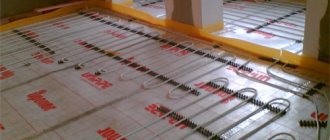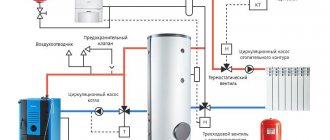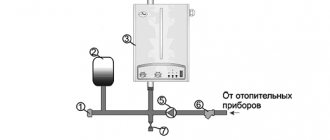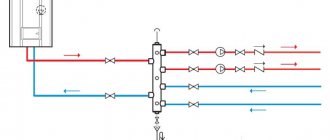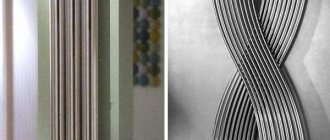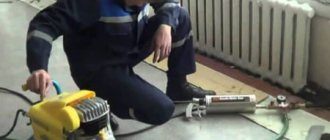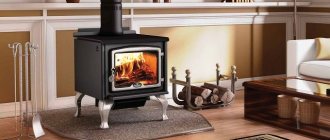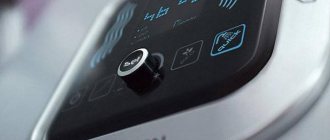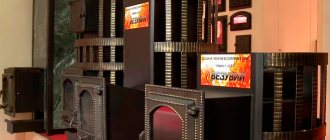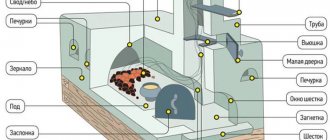Residents of multi-apartment buildings rarely encounter heating problems, since they are connected to a central system and do not think about whether to heat the house with wood, gas or electricity. But in private homes it is necessary to install boiler rooms, the financial costs of using and installing which can be reduced through the use of electric heating boilers. Thanks to it, the efficiency improves. Also, the water supply becomes uninterrupted, while its volumes increase.
Installing an electric boiler into the system
Selecting the right model
Almost all electric boilers on the modern market for heating a private home are suitable for everyday use. The same cannot be said about water heaters. And yet, on the market you can choose a device that can cope with uncharacteristic loads:
Tanks of various capacities
- The inlets and outlets on the tank must be located in a special way. The optimal combination includes a bottom inlet and a top outlet. This way the heated coolant will enter the system without mixing with the cold liquid.
- Outlets must be at least 2 inches in diameter. This will allow you to connect to heating pipes directly, without adapters.
Note! Most household heaters have an inlet and outlet with a diameter of 3/54 inches - this is not enough for connecting to radiators
- The optimal power of a storage electric water heater is 1 kW per 10 square meters of area. As you can see, household models can only be used in small houses.
- Instantaneous electric water heaters for home heating should be chosen for the same reasons. In this case, the power of the heating element must be at least 10 kW, since models of 5-7 kW are suitable only for a washbasin or shower.
Heating requirements
In addition to the electric boiler itself, other parameters will also affect the heating efficiency
The installation instructions for electric water heaters advise you to pay attention to the following points:. Piping and radiator configuration
The more elbows and branches there are in the system, the worse the heating will work.
Configuration of pipelines and radiators. The more elbows and branches there are in the system, the worse the heating will work.
Advice! Try to install radiators as efficiently as possible, reducing heat loss and hydraulic resistance. The technology of such installation is shown in the video.
- The fewer warm air leaks from the room, the lower the load on the heating elements. Therefore, before starting heating design, high-quality thermal insulation of all building elements should be ensured.
- The key to the longevity of the installation will be timely maintenance and periodic prevention. Before the start of the cold season, you need to call a specialist, or carry out maintenance of the heating elements yourself.
Timely cleaning is the key to effective work
Heating inertia
Boilers are characterized by the rapidity of temperature rise in the pipes of the heating system. In 15-20 minutes the water heats up to 60°C. In this aspect, flow devices are inferior to traditional boilers. Heating water in a storage tank with a capacity of 150 liters takes 40-50 minutes. The rate of temperature increase is affected by the performance of heating elements. After turning off the electric boiler, the water in the heating pipes quickly cools down.
Instantaneous water heaters require several recirculation cycles to lower the liquid temperature to room temperature. In the event of an unexpected power outage, the water remains hot for some time. Necessary conditions for the use of flow-through units in heating objects such as a private house:
- A small heating area, which is dictated by the ratio of 1 kW of consumed electricity to 10 m² of area.
- High quality coolant for durability and normal functional condition of the working elements of the unit.
- To circulate the liquid, you need a pressure similar to a centralized water supply system - 4 atm. In models equipped with a circulation pump, 1.5 atm is sufficient.
Appearance of instantaneous water heater.
Instantaneous water heaters are used to heat a small cottage with an area of up to 80 m². This applies to outbuildings and country houses. Another area of application for such heating equipment is the installation of heated floors.
Types of electric heaters
Consider the most common ones below:
Electric boilers
- They are usually used for heating private houses on an ongoing basis. The instructions allow the use of equipment in heating systems with liquid coolant.
- A heating element:
- Heating element - used with oil, water or antifreeze. The design is the simplest, making it possible to smoothly regulate the power. Allows stepwise change in heating intensity due to the inclusion of one or more devices;
- electrode - compact, used only in water systems, with strict requirements for the coolant. The installation of additional equipment is required, which increases the cost of the system. Thermal energy is obtained due to the potential difference between the electrodes due to salts dissolved in water;
- induction is the most expensive, but the most reliable and durable type of electric heating boilers. They are used for any type of coolant; their operation is based on the principle of electromagnetic induction.
- Electric heaters are characterized by the highest energy consumption, but at the same time they have a number of advantages:
- simple installation;
- no separate room required;
- compactness;
- quiet operation;
- no emissions of combustion products;
- high efficiency.
Advice: before using electric boilers, it is necessary to make a reliable grounding.
Electric heating boilers in the interior of the apartment
Convectors
- Compact mobile devices - used in country houses and city apartments as an additional or independent source of heat. They can be wall-mounted or floor-mounted (often both use options are provided in one model). The operation of the device is based on the fact that cold air entering the device naturally or forcibly passes through heating elements and, heated by heating elements, rises up through a special grille. There are no restrictions or special conditions when using the equipment.
Instantaneous electric water heaters for heating Pahlem
Flow devices
Such electric heaters belong to a separate category of devices.
Structurally, they differ from storage boilers:
- more compact dimensions, since a storage tank is not provided;
- water enters the heater through the inlet pipe, and is then heated in a copper flask by powerful heating elements (5-25 kW);
- Once heated, the liquid enters the system immediately, and its flow is controlled by specially designed valves.
A flow-through heater makes it possible to obtain water at the required temperature in a short time. However, due to uneven and active energy consumption, heating equipment is almost never used. Electrical wiring cannot always cope with the increasing load.
In the photo - electrode heating
Advice: if you need to install the device as the main source of heat, perform a complete reconstruction of the structure's electrical network.
Most often, electric instantaneous water heaters for heating are used in small country houses. In this case, you need to correctly calculate the power of the equipment and lay reliable wiring.
Available “fuel” for heating devices can turn them into the main or additional source of thermal energy. When installing electric boilers, care must be taken to ensure their reliable grounding. If you doubt your knowledge, entrust the installation of devices to specialists. The video in the article will help you find additional information on this topic.
Pros and cons of boiler-based heating
Heating obtained from a water heating tank has its advantages and disadvantages.
| pros | Minuses |
| No special tools, skills or engineering education required for installation | The installation process, in terms of labor resources, is quite expensive |
| Boilers are much cheaper than heating boilers | The unit is constantly in operating mode |
| Thanks to the thermal insulation layer, water heaters spend less derived heat than space heaters | The water supply must be constant, which can cause corrosion to occur prematurely. |
| It is possible to use wall or ceiling mounting type, so they take up little space | There is no required power to heat a large area |
| The amount of resources consumed is scanty, electrical energy consumption is minimal | |
| Allows you to independently regulate the temperature |
Criterias of choice
It was said above that flow-through models can only serve one point in an apartment, but this is not entirely true. All water heaters are divided into pressure and non-pressure. The first can create the necessary pressure so that hot water flows from the tap and shower, but the second do not have this function.
The second point is management. There are hydraulic and electronic. The former do not have precise water control. It all depends on the amount of water passing through the device. A good example is when in the shower you have to turn the knobs for a long time to find the ideal temperature. A device without electronic control has a given heating element power. The more water passes, the colder it is. For this reason, electronically controlled water heaters are more logical and safer. There is no chance that if you open the tap too much, cold water will flow out, and if the pressure is low, you will be doused with boiling water.
Another important parameter is performance. It determines what temperature and at what values the water heater can provide. Performance accordingly depends on power. The minimum value starts from 2.5 kW. It is worth understanding that such a device will be able to provide a comfortable temperature for washing hands, but not the body as a whole or dishes. To use a shower, bath or wash dishes, the water temperature should reach 40-45 degrees. To do this, you will need a model with a consumption of at least 5 kW per hour.
To choose the best water heater for your apartment, you need to know exactly for what purpose it will be used. When they tell me in a store - advise me on how to choose a water heater, I always ask how many people will use it and how. If the answer is several and for all needs, then we immediately look at powerful devices; if you just wash your hands and rinse the dishes at the dacha, then you can get by with simpler models. Also, many buyers are concerned about which company to buy a water heater for their apartment. Of course, there are a number of famous brands that have made a name for themselves. These include Electrolux, Thermex, Unitherm. In my opinion, when buying and on a limited budget, it is better to look at the functions of the device rather than the person who made it.
Useful parameters may include additional filters, protection against hard water and scale, a check valve, adjustment of the minimum and maximum heating values, prevention of overheating of the device, and the presence of an operation indication. All these programs and functions are important, and if the choice is between a simple device from a famous brand and a more functional one from a little-known company, I recommend taking the second option.
Similar functions are found in mostly expensive models priced from 15 to 20 thousand. Of course, such a device is not cheap, but its service life is much longer due to additional options. There are companies that make models with very specific functions. For example, AEG has devices that can be powered by solar panels; the German company Stiebel Eltron can offer its customers water heaters with several adjustments for the water supply in the shower.
An important point when choosing equipment is wall mounting. Flow-through water heaters are small in size and light weight, but if you need to install it on a plasterboard wall, you will need special “mole” mounting accessories. The water heater must be connected strictly according to the instructions.
Considering that water heaters operate on electricity and are located in a humid environment, having protection against electric shock is very important. If it is not there, then you will need a special device capable of protecting the user from electric shock.
Differences between free-flow and pressure devices
The difference between a non-pressure device is that the pressure inside it does not exceed atmospheric pressure, while a pressure water heater always experiences the pressure of the main water.
The non-pressure device protects the tap installed at the inlet from tap water pressure. Models of this type have low power (2-6 kW), do not provide sufficient water heating and are most often used in dachas or temporary residences.
Non-pressure models are designed to serve one point, therefore they are equipped with a watering can, tap or a tap + shower set. The load is small and replacement of the wiring with a more reliable one is not required
The pressure device does not have attachments and is a mini boiler with an inlet and an outlet. One device can be simultaneously connected to several analysis points at once.
Their power is enough to provide hot water to a kitchen sink, a shower, and a couple more taps. There are 2 categories of pressure devices - single-phase (3-12 kW) and three-phase (3-30 kW).
The location of the pressure water heater is under the sink, on the wall or in a cabinet. It is able to maintain a set water temperature and has an automatic on/off function
The disadvantages of a pressure device are a higher price and increased electricity consumption, however, during a period of hot water outage in a city apartment in which a large family lives, one cannot do without it.
Why an electric instantaneous water heater is better than a gas water heater
The main advantage of electric heating systems, regardless of type and power, is that the installation of such devices does not require additional communications such as chimneys and a ventilation system. In addition, it is almost impossible to install a gas water heater in an apartment building.
Another aspect that deserves attention is that when installing instantaneous water heaters, you will not have to come into contact with representatives of the gas service and fire inspection, which has a positive effect on the nervous system and the family budget.
Unipump water heater tap. Is it worth taking? video
Connecting and starting electric heaters can be done independently, but installing a geyser, even if you have the necessary knowledge and tools, without involving gas service specialists is contrary to current legislation.
Features of wall mounting
Instantaneous water heaters are installed in a place convenient for control, most often on the wall near the sink or shower. For fastening to concrete panels or brick walls, dowels are used; for drywall (not recommended) - special moth-type devices. The product should be positioned according to the instructions; it should not be rotated.
If you plan to install the water heating device near the water point, that is, in the bathroom or in a combined toilet, make sure that the degree of protection is not lower than IPX4
Connection to the electrical network must be made through an RCD, especially if the manufacturer does not provide a protective automatic shutdown function.
A three-core copper cable is pulled from a common grounding panel, then either a differential switch or a circuit breaker is installed.
Installation diagram for instantaneous water heater: 1 – pipe with cold water; 2 – tap (mixer); 3 – shut-off valves; 4 – check valve + filter set; 5 – RCD; 6 – electrical panel
It is better to equip the supply pipes for a pressure water heater with ball valves - for ease of installation/dismantling. Remember that a free-flow device has only one pipe - for connecting cold water.
You can find out more about the rules for installing ducts in the article presented to your attention.
Manufacturers rating
For those people who do not pay too much attention to price, but want to buy a functional model from trusted manufacturers, I have prepared a rating of the most famous brands.
- Stiebel Eltron is a German company. The equipment of this brand is not cheap, but it is always quality, accompanied by a 3-year warranty. Devices from the Germans are distinguished by ease of connection and use and wide functionality.
- AEG is a German company with good quality. The brand has different product lines with a flexible pricing policy, but even the most inexpensive models are rarely included in the service. This makes them popular on the Russian market.
- Electrolux. The company is from Sweden, but the assembly is predominantly Chinese. Due to this and cheaper materials, the brand sells equipment similar to German companies, but with a cheaper price tag. The quality is at a decent level.
- Atmor. The equipment of the Israeli company is more common than the equipment of the brands mentioned above. Advantages - high quality, precise operation of automation, small size, low prices. Atmor equipment rarely offers a wide range of functions, but for those who need a budget option for a summer house or apartment, it is perfect.
- Timberk. Another Swedish brand. Among the features are low price, compactness, high-quality assembly and bright design.
Before purchasing, you should decide on the power and understand what functions are really needed in a particular case. Sometimes you will have to overpay for additional, but unnecessary options, and there won’t be much point in it.
Popular models
To conclude the topic, I will give a rating of popular and inexpensive models that are suitable for everyday tasks, are sold in many stores and have good reviews and ratings.
Electrolux NPX6 Aquatronic Digital
Electric instantaneous water heater with a small capacity of 2.8 liters per minute. It can operate with an inlet water pressure of 7 atmospheres, power - 6 kW. The control is carried out electronically, there is an indication of operation. Equipped with a thermometer, it will not turn on without water, and will not overheat the water. Position on the wall – horizontal, color – white. Weight – 1.67 kg. Price – from 8 thousand rubles.
CLAGE CEX 9
Wide functionality, can be controlled from the remote control. Operates at pressure from 0.5 to 10 atmospheres. The maximum heating temperature is 55 degrees. Power – 8 kW, productivity – 5 liters per minute. There is an operation indication, self-diagnosis, and an electronic temperature controller. The set includes a water filter, protection class - 5. It is mounted horizontally, there is a locking of the set temperature, that is, the child will not be able to change the settings. Weight – 2.7 kg. Price – from 20 thousand rubles. (Moscow).
Zanussi 3-logic 3.5 TS (shower+faucet)
Inexpensive model with a low power of 3.5 kW. The capacity is 3.7 liters. Maximum heating temperature is 50 degrees. Pressure from 0.7 to 6 atmospheres. Mechanical control, no operation indication. Protection class – 4. Heater – copper heating element. Positioned horizontally, shower head and faucet included. Connects to a 220 W outlet. Weight – 1.5 kg. Price – from 2 thousand rubles. (2nd store - Russia, Belarus, UA, Kazakhstan, 5th store, Moscow).
Electrolux NPX 8 Flow Active
Flow-through water heater with a capacity of 4.2 liters per minute and a heater power of 8.8 kW. The maximum temperature value is 60 degrees. Pressure up to 7 atmospheres. There is a thermostat, display, self-diagnosis. The kit includes a filter to purify water from impurities, which will extend the life of the heating element. Protection class – 4. There are programmable modes and intelligent operation control. Weight – 2.5 kg. Connects via a 220 W socket and is mounted vertically on the wall. Price – from 14 thousand rubles. (2 store, Moscow).
Timberk WHE 18.0 XTL C1
Powerful model with high capacity of 12.6 liters. Power 19 kW, requires three-phase wiring. The control is electronic, there are programmable modes, a display, and a maximum temperature limit. Protection class – 4, spiral heater. Pressure type, it is possible to connect several points. Weight – 4.2 kg. Mounts on the wall, vertically. Grounding is required. Price – from 18 thousand rubles. (2nd store - Russia, Belarus, UA, Kazakhstan, 4th store, 6th store, Moscow).
Electrolux NPX 12-18 Sensomatic Pro
Device with three-phase connection and consumption of 18 kW. Capacity – 8.6 liters. Heating temperature – 60 degrees. Spiral heater made of stainless steel. The kit includes water filters. There is electronic control, a display, protection against turning on without water, and self-diagnosis. There is a children's mode. Weight – 4.4 kg. Vertical installation, grounding required. Price – from 22 thousand rubles. (2 store, 3 store, 5 store, 7 store, Moscow).
Timberk WHEL-7 OSC
Inexpensive model with a beautiful design. Power - 6.5 kW, productivity - 4.5 liters per minute. Mechanical control, protection class - 4. The kit includes a filter, shower head, faucet. The location is horizontal. Price – from 4 thousand rubles. (3 store, 4 store, 5 store).
Stay up to date with the news
Specifications
Further:GO TO CATALOG › TO GET A CONSULTATION > |
Attention!Precautionary measures:Pool heaters - TERMOPOOL, can only be used with the pump turned on; if the pump is turned off, then gradually (in small portions) fill the fire with water until it goes out completely, to avoid negative consequences!!! If you do not put out the fire, the water in the spiral will heat up to a boil and begin to throw portions of boiling water into the pool, which can lead to burns!!! Fire safety rulesInstall the pool heater no closer than 5 meters from buildings, especially wooden ones. Make sure to keep flammable liquids and objects within 2 meters of the heater. The rest area around the heater, approximately 10 meters, should be cleared of dry grass. Try not to leave the heater unattended (especially during intense combustion); if you need to leave, ask an adult to supervise the operation of the water heater. It is prohibited to install heaters under tree branches. |
Electric water heater for heating
There are many ways to heat a house using unconventional methods. However, not all of them are sufficiently effective, although there are those that have confirmed their efficiency in practice. One of the effective options that has been tested many times in real life is the use of an electric water heater for heating.
The principle of operation of a water heater in heating
The design, which is non-standard at first glance, is characterized by relative ease of installation, as well as operational efficiency. Although this option is not without its drawbacks, it can be found in many domestic apartments.
- Main characteristics of the device
- What parameters are taken into account when choosing a storage device?
- Indirect heating boiler
- Installation of the boiler into the system
Selection of coolant for water heater and installation
The main technical parameter of the unit is the rate of heating of the coolant to a given temperature. When choosing a suitable model, you cannot be guided solely by the rated power indicated in the accompanying technical documentation. The expected operating conditions and heated area should be taken into account. The unit should be installed in a warm room to minimize energy losses. The electrical wiring must be able to withstand the maximum load generated by the water heater. Such data is indicated in the technical data sheet of the equipment.
Distilled water is considered the best filler. It has optimal heat capacity. For use in hot water supply and space heating systems, it is better to purchase a unit with closed heating elements. This design avoids scale formation. It is important to choose a device of the required power that is capable of coping with the functional tasks assigned to it.
Types of water heaters which type to choose
Water heaters can be storage or instantaneous. The former are effective, but bulky, and there may simply not be room for them in a small bathroom. In addition, with intensive use, such a storage device runs out of water, and you will have to wait until the device replenishes and heats a new portion.
With flow-through systems, this problem will not arise: the water heats up directly as it passes through the device.
Both storage and flow mechanisms can operate on electricity or gas. But since gas is almost never supplied to modern apartments, in this article we will focus on electric models. So, how to choose an electric instantaneous water heater?
Lifetime.
Spirals made of stainless steel are not subject to corrosion, even when used in salt pools with cleaning based on a chlorine generator, their corrosion will be less than 0.01 mm/year. Thus, the service life of a pool heater is practically unlimited and is at least 15-20 years.
| Stainless steel pipe |
Spirals made of black steel are susceptible to corrosion and aggressive environments, so their service life is much shorter than that of stainless steel spirals and averages 5-7 years. Termopool does not manufacture heaters from stainless steel
| Hot rolled pipe. |
How does it work
The instantaneous water heater is very simple. It consists of a small housing, inside of which there is a control unit, several heaters and a protection system. When the tap is opened, water begins to flow through the device, the control unit checks the pressure, and then turns on the required number of heating elements. If the water pressure is weak, then the device uses 1 heating element; if the pressure increases, then more heaters will be required to manage heating.
Among the advantages of instantaneous water heaters:
- Small sizes.
- Energy consumption only during operation.
- High heating rate.
- Aesthetic design.
- Low price.
- The heater is installed near the water discharge point, which reduces heat loss.
- There is no limit on the amount of heated water.
In other words, instantaneous water heaters are small, can quickly heat any amount of water, they do not spoil the interior, and their price is much lower than that of boilers.
Any device has its own nuances. Flow models often have greater power. This requires high-quality wiring and a separate connection point. Instantaneous water heaters cannot serve several points and the maximum can be installed on the faucet and on the shower in the bathroom. It is impossible to use two points at the same time, since the water heater will not be able to provide the required temperature for both flows.
When choosing, you need to consider the following parameter. If the instantaneous water heater is used frequently and for a long time, then the electricity bills will increase significantly. The energy consumption here is higher than that of boilers and this can only be compensated for by quick and infrequent procedures. If the family is large and everyone in it likes to swim for an hour, then you will have to pay a lot for electricity. This is an important point.
Equipment and accessories.
The flagship of the TERMOPOOL heater line is the VOLCANO PRO 50 model. Its package includes everything necessary for complete and fast heating of water. Namely: A 36m spiral reinforced with stainless wire (stainless steel pipe AISI 304 32*2mm), coated on the inside with heat-resistant enamel up to 1000 degrees. The lid is made of stainless steel AISI 304, (3mm) with reinforcements from a 15mm stainless steel square and decorative elements also made of stainless steel. The chimney is made of stainless steel. Consists of two pipes 0.5 m, diameter 140 mm, a valve and a deflector. A 0.8mm stainless steel screen that completely covers the spiral. The stand (made of 5mm steel and made using laser cutting) is covered with heat-resistant enamel. The grate is made of cast iron 20mm thick. Stainless steel ash bowl. Ring/Casing with decorative cut and door for convenient removal of ash. (made of stainless steel 0.8mm thick) height 180mm.
| VOLCANO PRO equipment |
For those who want to cover the heater with stone or install it in an existing oven, we have produced a series of BASIS heaters. The standard Basis set includes: Spiral (stainless steel pipe AISI 304 32 * 1.5 mm), coated on the inside with heat-resistant enamel up to 1000 degrees. The stand (made of 5mm steel and made using laser cutting) is covered with heat-resistant enamel. The grate is made of cast iron 20mm thick. Ring/Casing (0.8mm thick stainless steel) around the stand, height 150mm.
| Standard kit BASIS PRO |
Additionally for the BASIS series you can purchase: A cover that will increase the power of your pool heater by 15-20%. The cover is made of 3 mm. steel painted with heat-resistant enamel. The lid hatch allows you to install a cauldron, smokehouse or grill in its place. Combine heating your pool with cooking!!! The lid has an outlet for the chimney.
| Heater cover (VOLCANO LITE / BASIS) |
| BASIS series standard set on the left, with screen and cover on the right. |
The protective screen gives the finished look to the spiral. It protects you from heat and, unlike the coil itself, which is covered with soot and condensation smudges, keeps the heater looking beautiful for many years!
Boiler as a boiler
Electric water heater design
In order to correctly install a heat supply system based on an electric water heater, it is necessary to carefully study its design.
What does it include?
- The basis of the design is a storage tank in which the coolant is heated. The capacity of the tank determines the efficiency of the entire system, therefore, if we plan to use a device for heating water in order to ensure optimal temperature conditions for the entire room, then it is better to choose a tank with a maximum volume.
- The heating element located directly in the tank is responsible for heating the water. The heating element operates in automatic mode, which is set by the control system: as soon as the water reaches the required temperature, the heating element turns off.
- Most models on the market have an internal tank housed in a protective housing (pictured). A thermal insulation material is laid between the walls of the tank and the housing, which prevents heat loss to the external environment.
Flow devices
Flow-type electric heaters constitute a separate category of devices. Their design differs from the design of storage boilers:
- The dimensions of the flow-through device are more compact, since its design does not include a hot water storage tank.
- Water enters the heater through the inlet pipe, after which it is heated in a copper flask due to the operation of powerful heating elements (from 5 to 25 kW).
- The heated liquid immediately enters the system, and its consumption is regulated by specially designed valves.
Using a flow-through heater allows us to obtain water at the desired temperature very quickly - up to two minutes. But with this type of active and uneven energy consumption, electric instantaneous water heaters are practically not suitable for heating. This is due to the fact that the wiring cannot cope with the increasing load, and to install such a device as the main heat source, it is necessary to completely reconstruct the building's electrical network.
And yet, for small rooms like a country house, you can design a heating system based on a flow-through boiler. The main thing is to correctly calculate the power of the device and ensure sufficiently reliable wiring.
Selecting an electric water heater
Choosing an electric boiler for heating water and heating your home. it is necessary to approach the analysis of its functional characteristics very carefully, since it is the heating device in such a system that will be the “weak link”.
What should you consider?
- The most important factor is the power of the heating elements of the device. The more powerful the boiler, the more efficiently it will cope with heating the room. Household electric boilers have a power of 1.5 to 3 kW, semi-professional heating models can reach 6-12 kW. If possible, then you should choose just such a device, since a low-power model will always be on, which means it will quickly fail.
- Tank volume is also very important. The larger the volume, the more often the heater will “rest”, and the more electricity you will save. The optimal choice is a tank of 300 liters or more, but the high price of such models makes them not very popular. So you'll have to look!
Method of heating water with a water heater
In terms of the method of increasing the temperature of the energy carrier, a flow device does not differ from a storage boiler. The sealed tank is filled with liquid from a centralized water supply. Electric heating elements increase the temperature to a given level. Units of 2 types are characterized by some loss of thermal energy.
Diagram of water heating by the device.
In a storage boiler, the temperature of the liquid rises inside a sealed container with an integrated heater. Since the volume of the chamber is small, the process proceeds rapidly and with little heat loss. The design of such units includes:
- Electric pump.
- Storage tank.
- Mechanism for controlling water supply and heating temperature.
Flow units lack the first 2 components.
When is it advisable to choose electricity for heating?
Electric heaters for heating cannot be considered the most budget option, at least in our country, because the costs of equipment and its operation are quite high.
They are usually considered as an alternative option, connected to the system in case of interruptions in the gas supply or when there is no possibility of laying appropriate communications at all. Their price depends on the area they can heat.
Electric water heaters for heating EVPM-36
However, this method of home heating has a number of undeniable advantages:
- widespread availability. since when arranging a suburban area, electricity is carried out almost first;
- quick and easy installation of equipment. which you can do yourself;
- compactness;
- ease of control;
- no combustion products.
Classification of electric heating devices
Today, electric heating equipment can be grouped as follows:
- Mobile - heating convectors and oil radiators.
- Stationary - electric boilers, boilers, fireplaces, IR heaters and air conditioners.
- Air - space heating is carried out by heating the air, for which various equipment is used, including radiators, electric fireplaces, and convectors.
- Liquid – the coolant is water, antifreeze or oil. Electric boilers and boilers are used for this.
- Solid-state (emitters) - heat is transferred to any solid surface, and it then heats the air in the room. Typical representatives are infrared heaters, as well as radiant ones.
- Tubular - used in all types of heating electrical appliances. They have a wide range of characteristics, including power and performance. Made from titanium or steel.
- Tubular with fins - used only for heating gas coolants, as well as air. Equipment includes thermal curtains and convectors. They are usually made from stainless or structural steel.
- Block or block electric heaters - used if it is necessary to increase the power of the device. The coolant is a liquid or any bulk material. The most common type of household heaters with a coolant in the form of a liquid is with a thermostat. The equipment is made of steel, chromium-nickel alloy or copper.
Electric water heater for heating a private house
